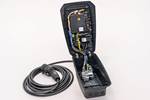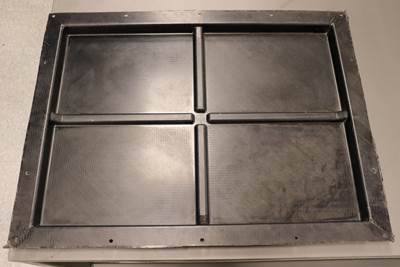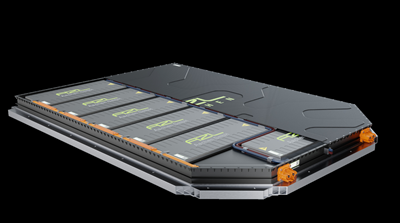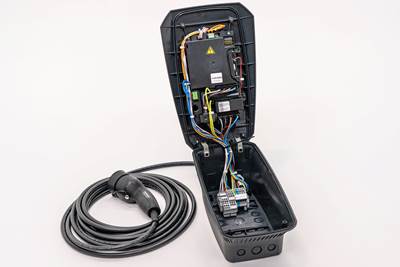Battery enclosure demonstrator testing proves EV feasibility, launches series production projects
Kautex Textron and Lanxess jointly developed and tested a PA6 technology demonstrator, reinforced with locally placed continuous fiber blanks, which passed all important mechanical, thermal tests.
Crush test in the Y direction. The results of the simulation match those of the physical component test well. Photo Credit: Kautex Textron
Kautex Textron (Bonn, Germany) and Lanxess (Cologne, Germany) have carried out a comprehensive examination using a jointly developed technology demonstrator made from polyamide 6 (PA6) and reinforced with continuous fiber to illustrate the technical plastics’ ability to meet the requirements of electric vehicle (EV) battery enclosures. Lanxess was responsible for the material development and Kautex Textron for the engineering, design and the manufacturing process of the demonstrator.
“The near-series demonstrator passes all mechanical and thermal tests that are relevant for such enclosures. In addition, solutions for the thermal management and leak tightness of the enclosure, for example, have been developed. This has all proven the technical feasibility of these safety components, which are complex and subject to high levels of stress,” Dr. Christopher Hoefs, project manager e-Powertrain at Lanxess, says.
At the moment, an enclosure prototype is being road-tested in a test vehicle to verify its suitability for daily use. “We are currently jointly tackling the first series-production development projects with automotive manufacturers in order to implement the new technology in series production,” Felix Haas, director product development at Kautex Textron, adds.
The demonstrator, which measures around 1,400 millimeters in both length and width, was developed based on the aluminum battery housing of a mid-size EV and designed for mass production. It is manufactured in a single-stage compression molding process with a molding compound based on the PA6 Durethan B24CMH2.0 compound from Lanxess, and does not require any further rework. Crash-relevant areas are reinforced with locally placed blanks made from continuous-fiber-reinforced PA6 Tepex dynalite 102-RGUD600. Compared with an aluminum design, weight savings are around 10%, enhancing range and thus the vehicle’s carbon footprint. The integration of functions, such as fasteners, reinforcing ribs and components for thermal management, reduces the number of individual components compared with the metal design, Lanxess notes, which simplifies assembly and logistical effort and reduces manufacturing costs.
Calculations revealed that the carbon footprint of the large-format plastic enclosure is more than 40% smaller compared to an aluminum design, Hoef reports. Reduced energy use in the production of PA6 compared with metal — in addition to other factors such as the omission of time-consuming cathodic dip painting to prevent corrosion where steel is used — helped to minimize the carbon footprint. The thermoplastic component design also makes recycling the enclosure easier compared with thermoset materials such as sheet molding compounds (SMC), for example.
The tests on the technology demonstrator were carried out in accordance with internationally recognized standards for battery-powered electric vehicles such as ECE R100 from the Economic Commission for Europe or the Chinese standard GB 38031. The all-plastic enclosure demonstrated its performance in all relevant tests. For example, it meets the requirements of the mechanical shock test, which is used to examine the component’s behavior in the event of severe shocks, and the crush test, which the developers use to examine the resistance of the battery enclosure in the event of slow deformation. The results of the drop and vibration tests were also positive, as were those of the bottom impact test. This test examines the stability of the batteries, which are mostly accommodated in the vehicle floor, in the event of ground contact of the vehicle structure, or impacts from sizeable stones.
“All test results corroborate the previous simulations and calculations. A critical failure of the plastic enclosure would not have occurred in any of the load cases,” Haas explains. The demonstrator also proved its resistance to external sources of fire underneath the vehicle in accordance with ECE R100 (external fire).
Related Content
The potential for thermoplastic composite nacelles
Collins Aerospace draws on global team, decades of experience to demonstrate large, curved AFP and welded structures for the next generation of aircraft.
Read MoreSulapac introduces Sulapac Flow 1.7 to replace PLA, ABS and PP in FDM, FGF
Available as filament and granules for extrusion, new wood composite matches properties yet is compostable, eliminates microplastics and reduces carbon footprint.
Read MoreInfinite Composites: Type V tanks for space, hydrogen, automotive and more
After a decade of proving its linerless, weight-saving composite tanks with NASA and more than 30 aerospace companies, this CryoSphere pioneer is scaling for growth in commercial space and sustainable transportation on Earth.
Read MorePEEK vs. PEKK vs. PAEK and continuous compression molding
Suppliers of thermoplastics and carbon fiber chime in regarding PEEK vs. PEKK, and now PAEK, as well as in-situ consolidation — the supply chain for thermoplastic tape composites continues to evolve.
Read MoreRead Next
UniFORM: High-quality, high-complex EV battery enclosures at low cycle times, low tooling costs
Stellantis subsidiary CpK Interior Products Inc. recently completed a design challenge to prove out its vacuum-assisted wet compression molding process for CFRP battery trays.
Read MoreAZL opens new project in cell-to-pack composite battery enclosures
AZL specialists are to kick off new project consortium Oct. 27, 2022 geared toward developing new battery enclosure concepts for cell-to-pack technology. Interested companies can still apply for participation.
Read MoreLanxess composite advances electric vehicle charging infrastructure
Halogen-free glass fiber-reinforced Durethan BKV20FN01 was used in the manufacture of charging cable connectors, demonstrates high tracking resistance and flame retardance.
Read More














.jpg;maxWidth=300;quality=90)











